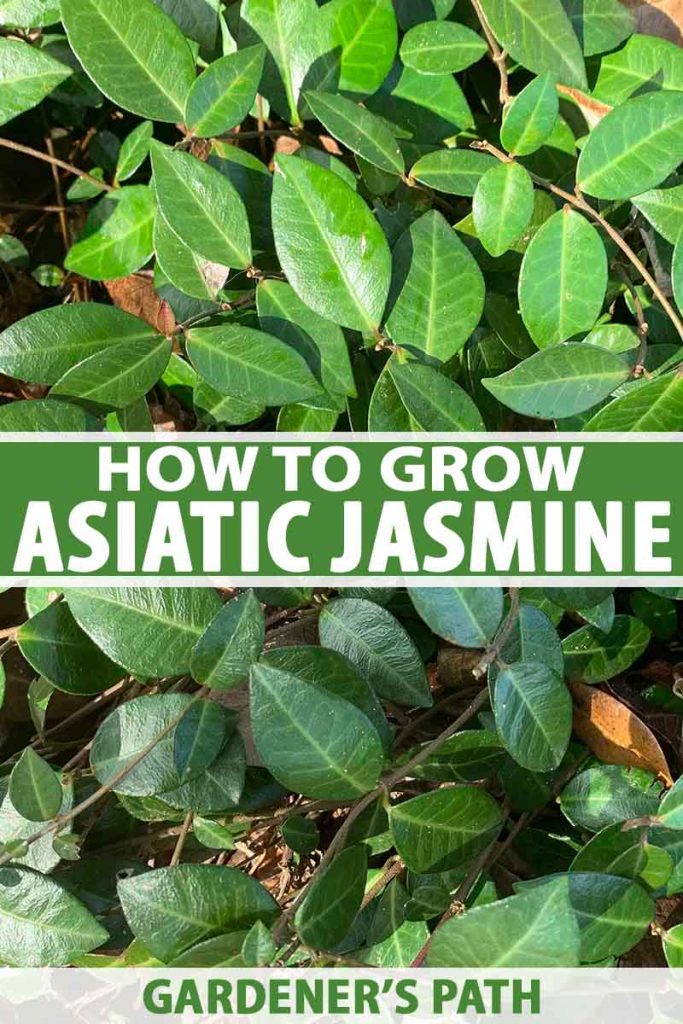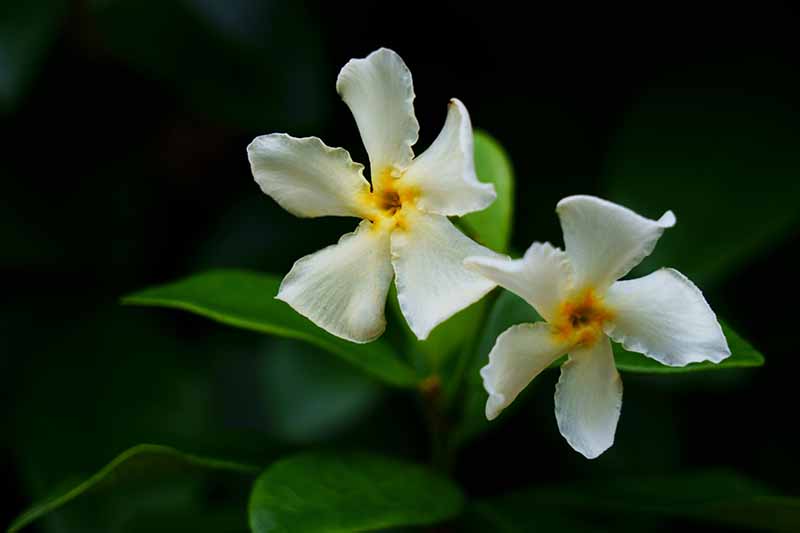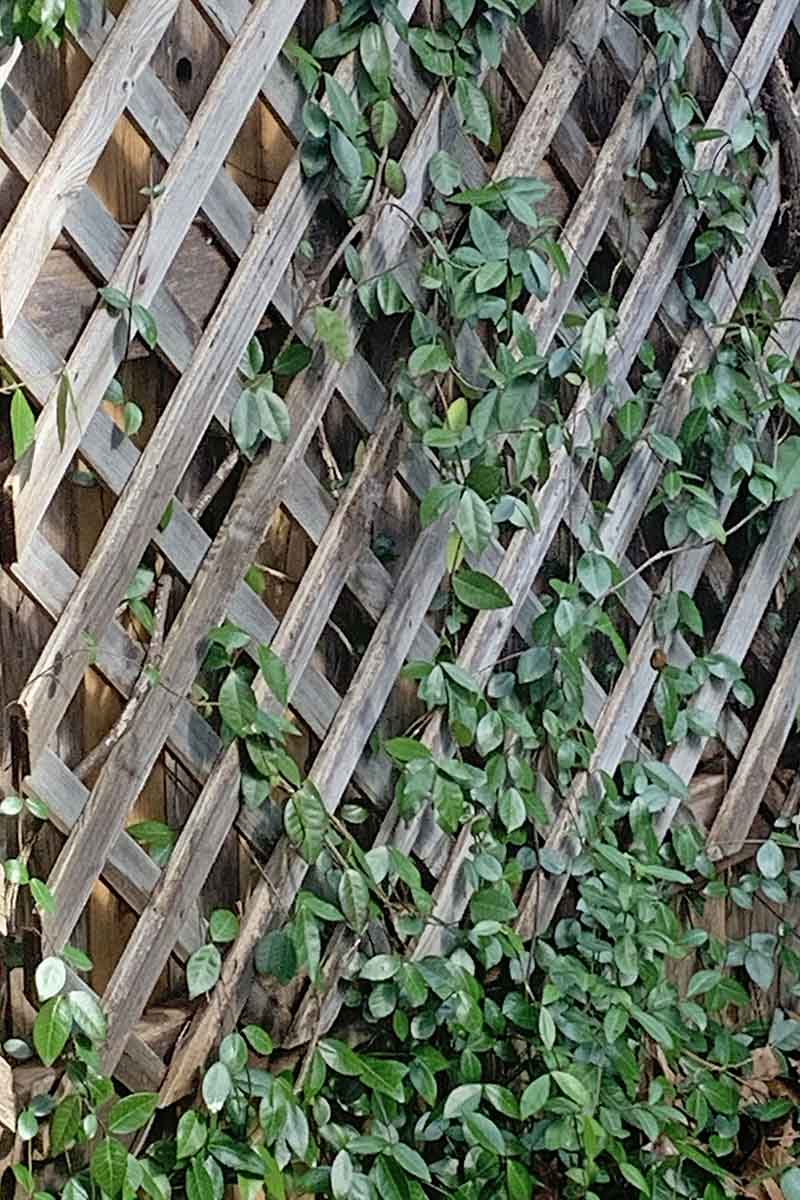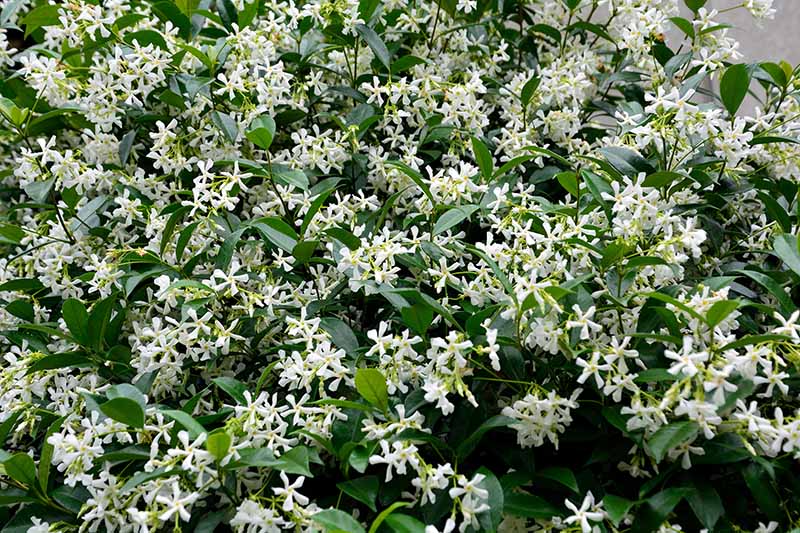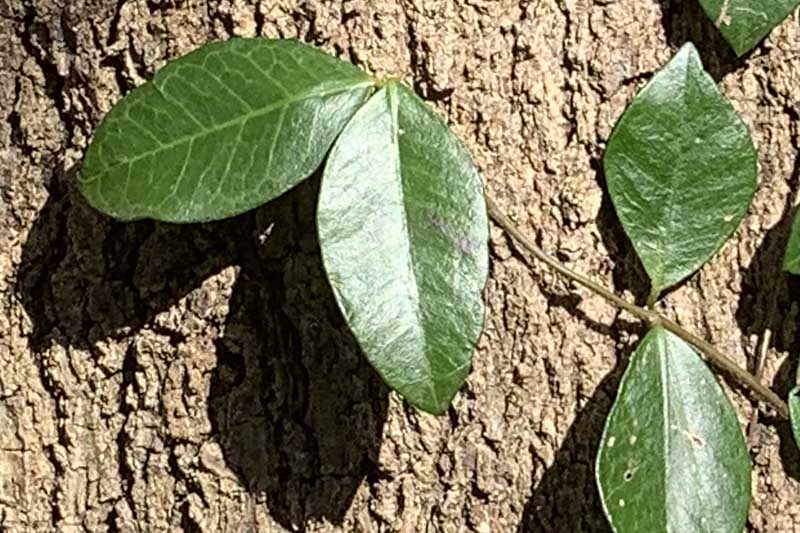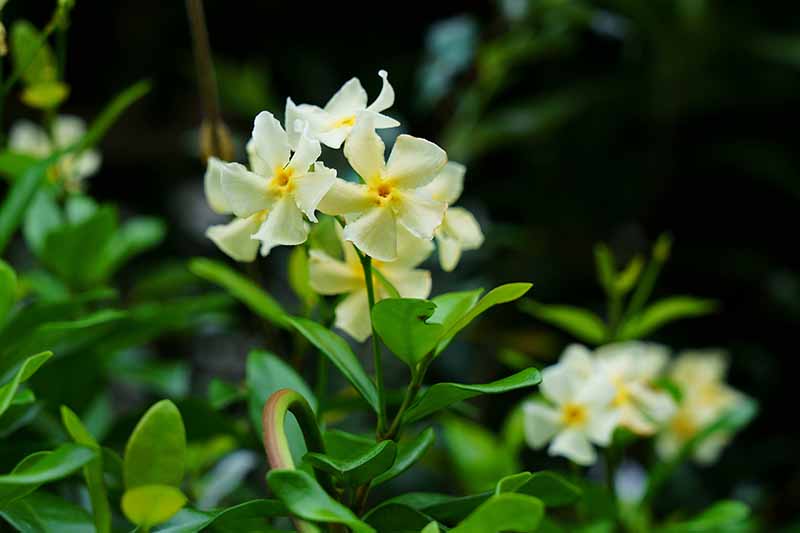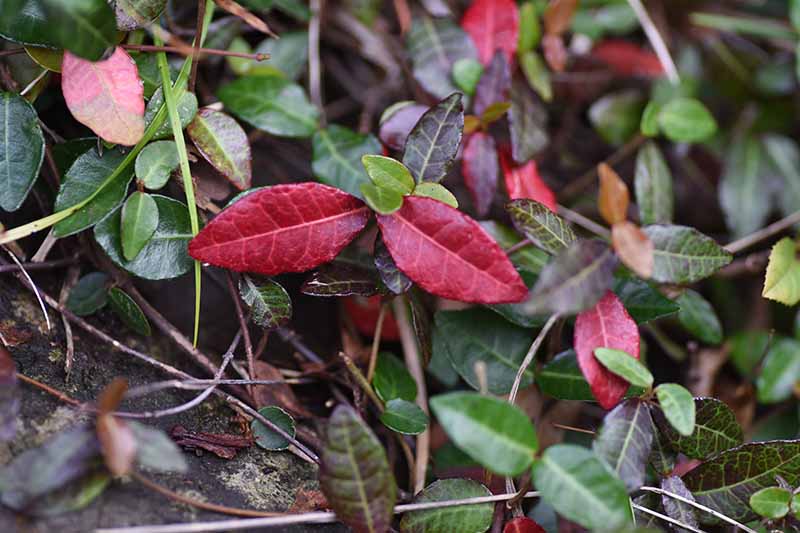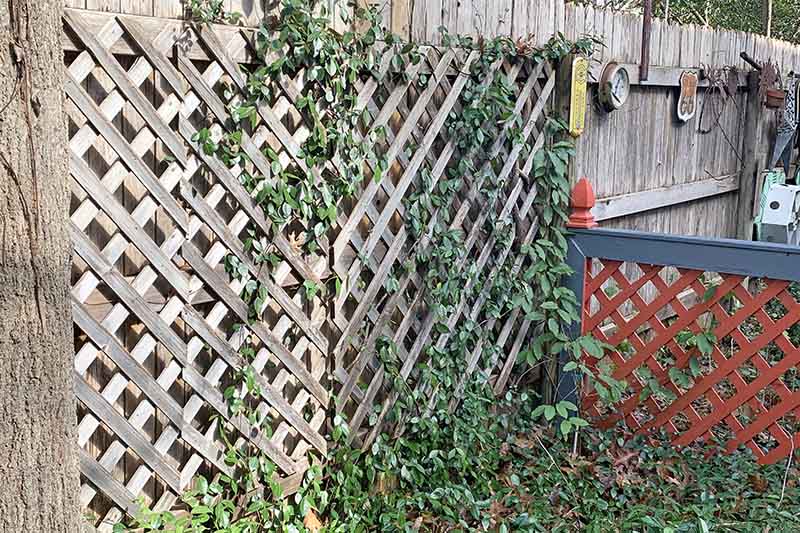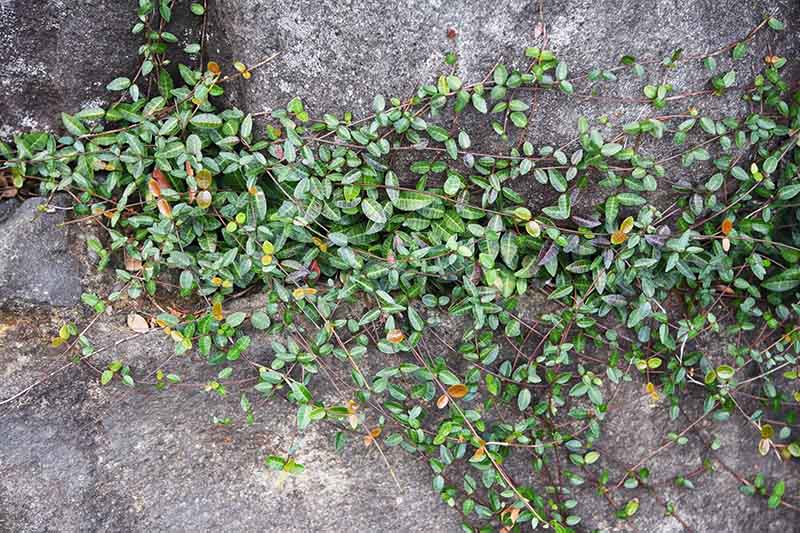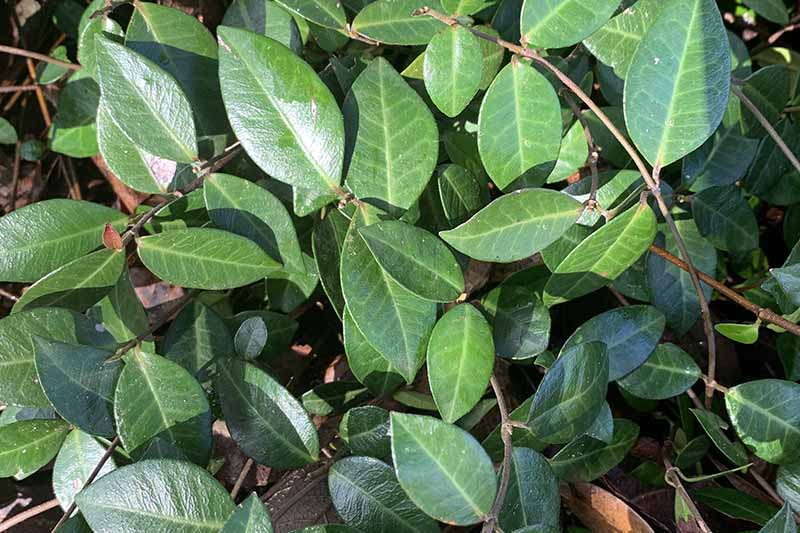It takes the second half of its name from its fragrant flowers, which – under ideal conditions – perfume the air in springtime. This fast-growing evergreen vine is appreciated for its ability to quickly cover a patch of land with a thick carpet of twining vines, even in shady areas. It’s also heralded for its tolerance of both heat and cold. We link to vendors to help you find relevant products. If you buy from one of our links, we may earn a commission. Are you thinking this plant might be the solution to your bare-earth problems? Read on to learn more!
What Is Asiatic Jasmine?
The small, dark green leaves of this deer-resistant plant are glossy and grow from red-brown stems that scramble along the ground and up trees, fences, and possibly your leg if you stand there long enough… Its five-petaled flowers are small, white, and delicate. If the weather is too hot, however, they won’t make an appearance. In Austin, we very rarely see a bloom on our Asian jasmine. T. asiaticum is hardy in USDA Hardiness Zones 7b-10. You could probably plant it in cooler zones but winter would kill it, and I can’t imagine why you’d plant a ground cover that dies in winter… But hey, you do you!
Incidentally, you may read advice on the internet where some native-plant purists spurn this vine because of its tendency to take over the garden. I understand where they’re coming from, but if you’re looking to quickly cover a wide swath, especially in a shady area, Asian jasmine is really unbeatable. While T. asiaticum is an excellent ground cover, it does not bear foot traffic well. If you’ve got an empty area that you’re looking to fill with something fragrant that can stand up to a little stomping, consider these culinary herbs and flowering options instead. Also, we want to give you a heads up about another plant that is sometimes confused with Asian jasmine. T. jasminoides, also known as star or confederate jasmine, looks similar to T. asiaticum. But it’s definitely more of a climbing vine, and it’s more likely to flower profusely under a variety of conditions. The genus from which Asiatic jasmine borrowed its name, Jasminum, includes about 200 shrubs and vines in the olive (Oleaceae) family that are native to Eurasia and Oceania. We list some of the most popular varieties here. Common jasmine, Jasminum officinale, is native to Iran and is beloved for its attractive and fragrant flowers.
Cultivation and History
T. asiaticum was first described in Western literature by German botanists Philipp Franz von Siebold and Joseph Gerhard Zuccarini in 1846, following von Siebold’s visit to Japan in 1823-1829. The pair labeled the plant Malouetia asiatica. Japanese botanist Takenoshin Nakai later reclassified the species according to modern taxonomic systems.
Propagation
Because Asian jasmine is a ground cover, you’ll likely want a lot of it. It does not grow from seed, but read on to learn other methods of propagation.
From Cuttings
Start by taking a 6-inch cutting from the tip of a vine shoot. Using a clean, sharp implement, cut just below a leaf. Choose a small pot with good drainage and fill it with damp sand. Insert a pencil in the center of the sand to create a hole, and then remove it. Strip the leaves from the bottom half of the cutting, and dip the end into a rooting medium, such as a powdered rooting hormone. Place the cutting into the hole in the sand and water well. Cover the container with a plastic bag to retain moisture, and water every day. Place it in a windowsill that gets indirect light, or outside in an area that is largely shaded. Alternatively, after dipping it in rooting hormone, you can place your cutting into a glass of water. After roots develop, in about a month, transplant to small containers filled with potting soil. Peat pots are terrific because you can transplant the whole thing to the ground when the rooted cuttings are ready, which will be in another 3-4 weeks.
From Seedlings or Transplants
You’ll find flats of small jasmine plugs at many nurseries, or online. Simply dig a hole about the same size as the container from which you are transplanting, and drop your plug in. Backfill if necessary, and water well. If you live where it’s quite hot, you’re best off planting in the fall; otherwise, plant in the spring.
How far apart you space them is dependent on how patient you are and how big your budget is. If you want an almost-instant carpet, buy lots and lots of plants and space them eight to 10 inches apart. If budget is a factor, and you’re patient, you can purchase fewer plants and space them 18 inches apart. Water newly transplanted plants every three or four days for about a month, and then water them once a week for another couple months. If you already have a large area of established Asiatic jasmine, you can “borrow” 1-foot-square sections of jasmine carpet to transplant to another area of your yard.
Use a very sharp shovel to cut out squares of the plant, digging up at least 3 inches of the roots. Cut these sections non-adjacently, so the remaining jasmine can fill in the areas from which you’ve removed your squares. Transplant these sections to the new area you wish to jasmine-ify. For best results, loosen the soil of the planting site, and “settle” your squares into their new home. Water thoroughly and frequently while the squares become established.
Layering
Asiatic jasmine often produces little clumps of roots along the stem at leaf nodes, at points where it comes in contact with something it perceives as a source of nutrients. This can be the ground, a tree trunk, or a fence picket, for example. These new roots can grow spontaneously, or you can encourage them to grow by burying a section of vine. Either way, you can cut off the bit with the roots after they develop, and plant these independent new plants wherever you’d like.
How to Grow
T. asiaticum will tolerate a wide range of soil types, as long as it is well-draining and has a pH of 5.5 to 7.0. Mine grows perfectly well in rocky clay soil. It will grow faster and more aggressively in soils with a higher percentage of organic content. You can plant in areas that get full sun, part sun, or full shade. Once established, these vines are fairly drought tolerant. If you see some wilting during a long dry spell – particularly if planted in full sun – simply give the plants a good shower, and they’ll perk back up with no long-term ill effects. The only time I water mine is in July and August, when it’s deathly hot and dry. If you want to fertilize, apply an NPK 10-10-10 fertilizer at the start of the active growing season. I have never fertilized mine and they do very well.
Growing Tips
Plant in sun or shade Irrigate mature plants when you see the leaves wilting Apply a balanced fertilizer in spring, if you like
Pruning and Maintenance
The only maintenance Asiatic jasmine really needs is pruning. It can spread rather assertively, and you may find it escaping its prescribed boundaries with abandon.
No matter. Just get out the string trimmer and whack away. It doesn’t mind a bit. You can, of course, simply use pruners. But that can get tedious if you have a large area of this plant. Some gardeners even use a lawn mower to keep these vines in check. Be sure your cutting implements are sharp, so the cut ends of the vines don’t end up unattractively ragged. Whacking away at the ends encourages the plant to branch more from the truncated stems, so you’ll end up with a thicker carpet. Bonus! See our complete article on how to prune and control Asian jasmine for more tips.
Managing Pests and Disease
The only disease problem you may see with Asian jasmine is leaf spot caused by the fungus Cercospora, which produces individual tan or light brown spots with red-purple borders. For example, T. asiaticum ‘HOSNS,’ also known as ‘Snow-N-Summer,’ is a cultivar developed by Monrovia. ‘Snow-N-Summer’ Its leaves start out pink, then turn white, then mature to variegated white and green. The plant produces small, tubular, creamy yellow flowers that are fragrant. From Japan comes T. asiaticum ‘Kiifu Chirimen,’ a dwarf variegated Asian jasmine whose small leaves grow in copper-bronze and mature to pewter-silvery green. T. asiaticum ‘Gold Brocade’ or ‘Ojon Nishiki’ is another cultivar from Japan. It grows variegated foliage that emerges in red and orange, and then matures to gold and deep green. If you have a severe infection, which is rare, you can treat your plants with a fungicide. Otherwise, don’t worry about it, because rarely is fungus a severe problem for Asiatic jasmine.
Best Uses
Asian jasmine is most often used as a ground cover, though some of the cultivars that are available make attractive additions to hanging planters.
Quick Reference Growing Guide
It’s drought tolerant, un-pestered by bug or beast, and frost tolerant. Its small, deeply colored leaves make an attractive carpet of green. Have you grown Asiatic jasmine? Share your expertise in the comments section below. Looking for information about other drought tolerant plants? Check out these articles next:
How to Grow Texas Mountain Laurel How to Grow and Care for Spirea Bushes How to Grow and Care for American Beautyberry Shrubs
Photos by Gretchen Heber © Ask the Experts, LLC. ALL RIGHTS RESERVED. See our TOS for more details. Product photo via Andryani. Uncredited photos: Shutterstock.
